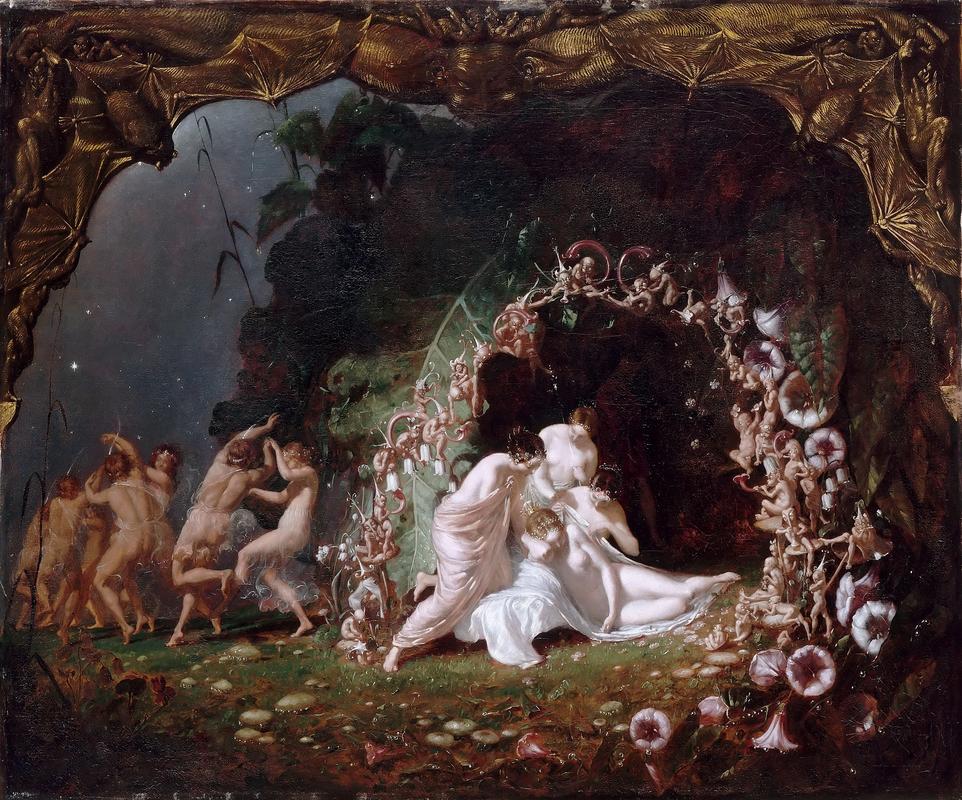More about Titania Sleeping

Sr. Contributor
In this Richard Dadd painting a beautiful fairy queen sleeps peacefully while her trash pile of a husband lurks behind her in the shadows.
It’s safe to say that Titania’s fairy attendants aren’t very trustworthy since Oberon is standing directly behind them. Anyone familiar with "A Midsummer Night’s Dream" knows where this scene leads: Oberon pours a love spell over Titania’s eyes to make her fall in love with an ass. I don’t care who has the literal donkey head in the play, it’s obvious who’s the real ass.
Richard Dadd always had an interest in fairies and in Shakespearean subjects. When this painting premiered alongside his other work, Puck, he established himself as a preeminent fairy painter. Oberon and Titania were both frequent subjects for him, appearing in three total paintings including his unfinished masterpiece.Titania Sleeping was the first, and the second, called Contradiction: Oberon and Titania, is rendered in such a different style that side by side you might think it was painted by a different artist entirely. It also serves to showcase a completely different side of Titania. Here, she’s helpless while she’s sleeping, because even though she’s surrounded by her attendants and many smaller fairies, none of them bother to stop Oberon. The bats are blameless since they just make up the stage curtain.
In Contradiction: Oberon and Titania, she stands strong against her terrible husband. She holds a wand that’s as tall as the spear he wields. She’s so focused on her anger that she doesn’t even notice the small fairy she’s crushing under her foot. Dadd’s rendition of the scene places them as equals power-wise, which really just retroactively emphasizes how cowardly Oberon’s scheme is here.
The works were painted thirteen years apart, but that’s far from the only reason for the differences in Dadd’s style. Roughly a year after exhibiting Titania Sleeping, Dadd went on an expedition to tour the Mediterranean and Egypt. He suffered a stroke while sailing the Nile and began to suffer from delusions - delusions that led him to murder his father, believing him to the incarnation of the Devil. Dadd lived in an asylum for the remainder of his life. Contradiction: Oberon and Titania was painted while he lived in the asylum. Another piece he worked on around the same time, Mercy: David Spareth Saul’s Life, was a potential form of catharsis for Dadd.
The final painting of Dadd’s in which Titania and Oberon appear is The Fairy-Feller’s Master-Stroke, the aforementioned and unfinished masterpiece. It’s notable that they’re the only characters that didn’t come from Dadd’s imagination, but it’s really just a cameo. They only help fill out the crowd waiting for the chestnut to be chopped.
Sources
- Contradiction: Oberon and Titania, by Richard Dadd, 1817-1886. Accessed February 17, 2022. https://victorianweb.org/painting/dadd/paintings/6.html.
- Dadd, Richard, and Grande-bretagne. “Le Sommeil De Titania.” Musée du Louvre, January 23, 2022. https://collections-louvre-fr.translate.goog/en/ark:/53355/cl010066624?… _sl=fr&_x_tr_tl=en&_x_tr_hl=en&_x_tr_pto=sc.
- Lippincott, Louise. “Murder and the Fine Arts; or, a Reassessment of Richard Dadd.” The J. Paul Getty Museum Journal, vol. 16, Getty Publications, 1988.
- Newall, Christopher. A Celebration of British and European Painting of the 19th and 20th Centuries. London: Peter Nahum, nd [1999?]. Pp. 10-12.
- Pask, Kevin. The Faerie Way of Writing: Shakespeare to Tolkien. Baltimore, MD: The Johns Hopkins University Press, 2013.
- Prasad, Vaijayanti. “Richard Dadd Detailed Biography, Book, Poem, Early Life and Paintings.” Richard Dadd Detailed Biography, Book, Poem, Early Life and Paintings,victorian-era.org/richard-dadd-detailed-biography.html.
- Shakespeare, William. A Midsummer Night’s Dream. USA: Yale University Press, 1918.
- “'The Fairy Feller's Master-Stroke', Richard Dadd, 1855–64.” Tate. Accessed February 17, 2022. https://www.tate.org.uk/art/artworks/dadd-the-fairy-fellers-master-stro….











